#neat resource/reference
Explore tagged Tumblr posts
Text
I see the gays are going to loose their minds over Jasmin's public journey with queerness. And some of you are sounding a lil too much like Afterellen writers.
To yall and to anyone who feels the same as her might i suggest this interview:
youtube
Or any of these links / books. which i'm using good reads links so you can see the triggers or content warnings to not be blind sided.
Stone Butch Blues by Leslie Feinberg (good reads link but you can find the book for free) tw assault, this is not a book for minors
Zami by Audre Lorde (good reads)
My Gender Workbook (good reads) and Gender Outlaws: both the original and the 2010 version by Kate Bornstein
This SLATE article from 2015 (slate article) (wayback in case that link breaks)
These reddit posts with a valley of insight in the comments from older much older queer, gay, and lesbian people: Thread 1 Thread 2
A study done in 2009
Bodies in Relation—Bodies in Transition (article here)
Youtube videos and maybe a documentary
Queer Theory 101- Part 1- An open discussion with Ben Bateman- 30 min and there are 2 parts (go to youtube)
Brief Lecture Introducing Concepts of Queer Theory with Professor Matt Alberhasky- 10 min (go to youtube)
Judith Butler explaining Gender Theory- 13 min (youtube) and their book Gender Trouble: Feminism and the Subversion of Identity (good reads): and i will quote them here "Stumbling is a part of learning and making an error is a part of learning." & "Many people who refuse to allow trans people to define themselves is that they feel their own self definition is destabilized."
The Aggressives (free tubi link but you can arrgh matey it if you try hard enough) , a 2005 documentary, directed by Eric Daniel Peddle. An insightful exposé on the subculture of masculine presenting POC and their "femme" counterparts. Filmed over five years in NYC, the featured subjects share their dreams, secrets and deepest fears. Some of the AGs in this video identify as trans men, non binary, or bi now but all of their experiences are valid.
And if you were wondering yes, yes i do love researching and having references. Its fun.
This might be shocking but there are older lesbians and i am talking the most butch blue collar trades dyke with silver strands who have done way more things that would make some of y'all squeem because its not within this very linear view of what some people view should be everyone's exact labeled experience should be. And yes they still fully identify as lesbians and are in very long term commited lesbian relationships their past has just been a lot. No two people are the same and many people will have a definition similar to you but an entirely different and layered experience. This also includes experiences and journeys with labels that you are going to feel uncomfortable with if they open up about the journey that it took them on to get to the same label you use. I tend to say that is for thee does not have to be for me. Sometimes the moments of others journey albeit will be cringey to you and others but they aren't directly harmful to you and your experience. No matter what we will all still be hit on by people and certain demographics that we do not want to be hit on, because they do not care. Tearing apart your communities in person and online over drivel and people just on their journey whilst learning does nothing for us when that is what those in opposition are banking on. Now unclench and breathe.

#my thoughts#queer#jasmin savoy brown#look at these books aren't they neat#queer theory#resources#lesbian#bisexual#trans#gay#queer history#book suggestions#references#Youtube
48 notes
·
View notes
Note
hey @pukicho i saw your art and i thought it was super cool! you improved so quickly (really impressive btw), and i was wondering what resources used to study art? and what app/website you digitally draw on? and your brushes if your okay with sharing them? and literally ANY other information you had because i would love to learn how to draw?
i feel like a victorian street rat asking for more bread
I use an XP-Pen Pen Tablet and Clip Studio Paint as my program of choice, but any pencil and notebook will suffice for learning, and may even be better. As for learning, I use books, baby!!! BOOKS! I'll even be nice and tell u which ones, because I am a lover of shared knowledge:
How To Draw by Scott Robtertson - deceptively complex book on perspective. It tells you how to draw a box, I then suggest you draw a fuck-load of boxes in correct perspective before moving forward. Having a strong grasp on planes and perspective allows you to properly grasp the volumes and shape of almost anything. It's the baseline principle to visualizing what u wanna draw. Without simple forms understood in perspective, you merely lack the skills necessary to draw from imagination.
Carlson's guide to landscape Painting - A good book, even if u don't intend to draw landscapes. Tons of clever explanations on lighting and value. Tons of useful relational shortcuts to understand complex scenery in smarter ways. I like the way he explains things, it makes me go ohhhh.
TACO point character drawing 1 & 2 - Two NEAT anatomy reference books. It's mostly just a collection of simplified, anime-esque proportional figure drawings. They're a great reference, but I absolutely wouldn't use it as my only set of books on anatomy. It's still useful to use and learn, but in a more general way - and I can't currently apply everything the book tells me yet, because I haven't learned the forms in more detail first.
The Human Figure by Jon H Vanderpoel - this is a short, but VERY useful anatomy reference book. The Author is from the early 1900s - real oldschool, which is good. He has a very useful, matter-of-fact writing style. This is the better starter book to use in order to remember the proportional relationships of the human body (even then, it's still not enough)
The Practice of Oil Painting & Drawing by Solomon J. Solomon - I'll be honest, this one makes sense to me conceptually, but I cannot fucking execute some of his practices. This dude is from the victorian era, his paintings are in museums and they're too good. It only makes sense that his views and approach to art are headier than some of the other suggestions on this list. The book is still useful, and I presume will only grow in usefulness as I learn. It does still have some cool ideas in the first-half of the book that you can easily apply to your art studies! But the second half is a series of master-derived schools of learning that I have yet to dare touch.
(also check out loomis books. I hear they are good)
ENJOY
1K notes
·
View notes
Note
Was bounty hunting in the Old West as popular as the movies make it out to be? The actual history I've read suggests that that niche was mostly taken up either by private detectives from agencies like Pinkerton or by straight outlaws. Were movie-style bounty hunters mostly a myth?
Movie style bounty hunters were almost exclusively a myth. There were the odd exception here or there, but the concept of an old west bounty hunter didn't really exist until the 1950s.
The term, “bounty hunter,” is a little anachronistic as well. While there were people called bounty hunters in the 19th century, the term primarily referred to mercenaries. Specifically this was in the context of any signing or campaign completion bonuses that they would receive. That was the, “bounty.”
Using the modern term, most bounty hunters in the old west were actually local law enforcement officers, who relied on the cash payout bonuses from arrests. (And, in the case of these bounties, thinking of it as a pay bonus for law enforcement really is instructive.) In other cases, law enforcement officers would use a portion of those payouts to entice civilians to assist them in making potentially dangerous arrests.
Private detectives, including the Pinkertons, also sometimes tracked down outlaws, and as with law enforcement, the bonus pay was an enticement. Amusingly, Wells Fargo used to also operate bounty hunters specifically tracking outlaws who'd targeted their property. Though, other contemporary companies did the same. In this case, it's less of a “bounty hunter,” and more of a corporate enforcer, hunting down someone who'd crossed the company.
Another interesting thing to be aware of is that those wanted posters were not publicly distributed. There also wasn't a universal format, or source. Some were distributed by the Pinkertons (though, I'm not entirely clear on whether those were given to law enforcement or primarily kept for internal use, though at least some of their circulars did end up in the public record and have been preserved.) In a lot of cases, these were just a written description of the criminal, and a posted bonus (usually $100 or less.) I'm not completely sure how rare the posters were at the time, but very few have survived into the modern day. So, this was more of a resource for law enforcement, rather than something offered for public consumption. The image of a board of wanted posters presented for anyone wandering psychopath to peruse is a fantasy.
Freelancers, such as they were, seem to have been mostly working for private interests. These were often military veterans who would happily hunt down suspected criminals (such as cattle rustlers) and dispatch them. In general, that ends up looking a bit more like murder-for-hire, rather than what you'd think of as a modern bounty hunter, though it may inform some of the modern perspectives on the job. These are the ones you're probably seeing that get categorized as outlaws, and there is quite a bit of truth to that.
A sort of neat bit of trivia, the modern bounty hunter, (also, more commonly known as a bail bondsman, or bail bond agent), is a very old profession. However their history in the United States originated in San Francisco in 1898. The Old West came to an end in 1912 (generally), so there was a period of 14 years where modern bounty hunters existed in America, before the wild west was officially over. So, in that sense, there is some actual overlap, but it's not what most people think of when talking about a “wild west bounty hunter.” (And, on the subject of, “officially over,” it's worth remembering that the last range war in Wyoming took place in 1909.)
The image of the bounty hunter as a sort of freelance cop, who wanders around arresting outlaws, is a product of highly sanitized 1950s westerns.
-Starke
This blog is supported through Patreon. Patrons get access to new posts three days early, and direct access to us through Discord. If you’re already a Patron, thank you. If you’d like to support us, please consider becoming a Patron.
#writing reference#writing advice#writing tips#how to fight write#starke answers#wild west#bounty hunters
429 notes
·
View notes
Text
Writing a "Perfectionist" Character

Perfectionism
The tendency to demand of others or of oneself an extremely high or even flawless level of performance, in excess of what is required by the situation.
It is associated with depression, anxiety, eating disorders, and other mental health problems.
Traits & Symptoms of Perfectionists
While there are several ways to define and describe perfectionism, most theories identify the following 3 features (or traits) of perfectionists (Antony & Swinson, 2009):
Adopting standards that are extremely difficult or impossible to meet.
Setting expectations so high that they damage, rather than enhance, their performance.
The presence other mental health problems, including depression and anxiety.
Symptoms of Perfectionism
Unreasonably high standards and expectations can be harmful throughout our lives, damaging enjoyment and performance and preventing engagement across many situations, including (Antony & Swinson, 2009):
Career and educational performance. Perfectionists at work and in school settings often set overly strict standards for themselves and others, leading to too much time measuring and assessing, and resulting in delays and missed deadlines. Perfectionist managers may become angry when an employee arrives late, even when they complete extra hours later in the day. Students who set themselves too high standards may feel depressed unless they are at the top of the class.
Neatness and aesthetics. Extreme neatness and cleaning may leave perfectionists with little time for other activities or may hold them back from beginning an activity if it may leave a mess. An excessive tidiness focus can lead to upset and disagreement at home and outside.
Organization. As with neatness, if things are left disorganized or not set out in a particular way, perfectionists may experience anxiety or react angrily. They may spend hours planning and making lists, yet still failing to engage in the task.
Writing. Sending emails, filling in forms, completing assignments, and even writing in a card may be delayed due to fear of making mistakes, making the process of writing tortuous.
Self-consciousness in speaking. Perfectionists may be overly self-conscious regarding what they say and how they say it, and may be unduly concerned with incorrectly pronouncing words.
Physical appearance. People with perfectionist standards can set impossibly high standards regarding their hair, clothes, weight, and body image. Individuals may be late for work, prioritizing their time on finding the perfect outfit.
Cleanliness. Perfectionist behavior may focus too much on health and wellbeing. Health-obsessed individuals may be concerned about touching anything or eating something they haven’t prepared, and frequently visit the doctor.
Ultimately, for people with impossibly high standards, only the impeccable can be accepted. Failing to reach this level can be so devastating it may not be worth trying to succeed at all (New Scientist, 2019).
Sources: 1 2 ⚜ More: Notes & References ⚜ Writing Resources PDFs
#perfectionism#psychology#writing reference#character development#writeblr#literature#writers on tumblr#dark academia#spilled ink#writing prompt#creative writing#light academia#writing inspiration#writing ideas#lit#mary cassatt#writing resources
209 notes
·
View notes
Text
Jasper's Servitor/Thoughtform Resource Post

last updated: December 23, 2024
Please note: The biggest difference between a servitor and thoughtform is the level of sentience (or perceived sentience). A servitor is not sentient, while a thoughtform is. Determine it as you will.
Also, a disclaimer! Even if I don't find a source particularly helpful, you might get more out of it than I did! I just like to categorize and sub-categorize things.
Tumblr Posts I Find Helpful
How to Make a Servitor by viadescioism: A rather straightforward guide on servitor creation.
Creating a Thoughtform by windvexer: A decently lengthy guide on thoughtform creation.
When Creating Thoughtforms by witchesalleyway: A little reminder about picking the shapes of your thoughtforms.
Technowitchcraft - Thoughtforms by aceswitch: A post with the idea of using a USB drive as the "body" of a servitor/thoughtform to allow for future edits.
Egregore by trustmepink: An extremely short post defining what an egregore is. Great for being introduced to the word and concept, though there's not much meat in the post and the sources/helpful links are a bit questionable.
Sigils: Scribbles to Forget or Spirits to Remember by witchofsouthernlight: While not about servitor creation, this is about reusing sigils for specific goals and how those can be spirits in an animist perspective. A really neat post overall and useful here because of the way that servitors are often tied to sigils.
Entity Creation Worksheet by jasper-pagan-witch: Adapted from Creating Magickal Entities, but altered to a decent extent so it's more helpful to me personally.
Servitor Design Template by ritual-and-chaos: Adapted from Servitor Magick, extremely straightforward with an explanation. A great alternative to my adaptation of the template from Creating Magickal Entities.
Chaos Magic: Servitors, Thoughtforms, and Godforms by trollkunnig: Incredibly in-depth and detailed when it comes to servitor creation, but since OP deactivated, the links in reference to the godform parts are broken. Damn the loss of information on the Internet!!!
Destroying Your Thoughtforms: by viadescioism: A fairly detailed (if a little wall-of-text-y) post on the destruction of the thoughtform, with a guide in case you didn't build a kill switch/phrase into your thoughtform to begin with.
Thoughtforms: Theory & Ethics by spiritvexer: A good companion post to the thoughtform destruction one above, giving a few alternatives to total destruction for the thoughtforms when you no longer need them.
Thoughts on Thoughtforms by spellsandwoo-woostuff: An insightful read into another approach to thoughtforms as OCs or writing muses given life rather than spells given sentience.
Basics of Servitor Creation and Implementation by majokkid: Part of majokkid's Magi Praxis series, this goes over the basic steps of servitor creation in a way that is straightforward, easy to understand, and works well even beyond magical girl-aligned practices.
Easy Ways to Charge Energyforms by windvexer: Goes over a bunch of different energy feeding and charging methods for servitors and provides resources for making this shit easier. And gods know we need to make this shit easier.
Books And Websites I Find Helpful
Condensed Chaos: An Introduction To Chaos Magic by Phil Hine: While this is a chaos magic 101 type book, it has an incredibly robust chapter on servitor/thoughtform creation. It also has the benefit of talking about chaos magic more broadly to give you more context for servitor/thoughtform creation. You can find my initial thoughts on it here. APPLICABLE PAGES: 106 to 125, under the chapter name "Chaos Servitors"
The Forty Servants, The Four Devils, and The Grimoire of The Forty Servants by Tommie Kelly: Two pre-made servitor systems that are incredibly in-depth and, in my opinion, quite fun to use. There's a little bit of plug-and-play applicable here.
Magickal Servitors: Create Your Own Spirits to Attract Pleasure, Power and Prosperity by Damon Brand: It is effective, straight to the point, and actionable. But interestingly, it's incredibly combative towards chaos magic, which is where servitor/thoughtform creation sprung up to begin with. You can find my initial thoughts about it here.
Tumblr Posts I Find Less Helpful
Creating a Servitor and Creating a Thoughtform by witchy-oates: These guides aren't bad, but they really seem to focus on the fear that a servitor will spontaneously develop sentience, which I generally disagree with.
Is Your Spirit A Thoughtform? by elysiumconjures: A lengthy questionnaire and list of red flags that an entity you're interacting with might be a thoughtform. Personally I found it frustrating to read, but the list can at least guide beginners who are still learning discernment techniques to figure out what to look for.
On Telling The Difference Between A Thoughtform And A "Real" Spirit by creature-wizard: The counter-post to the above one, though you kind of need to see both perspectives to fully appreciate creature-wizard's wonderful counterpoints.
Distinguishing Imaginary Friends, Thoughtforms, and Spirits by spiritconnect: Another post about deciphering whether what you're talking to is a thoughtform or some other kind of entity.
A Short Guide to Thoughtforms by thewitchofbucktown: Longer than it promises, and I personally don't feel like referring to all deities as thoughtforms is something that works with my understanding of things at this time, but not a bad post considering it was written 11 years ago. Plus, OP hasn't deactivated, which is really hard to find in servitor/thoughtform resources.
Servitors: A Basic Guide to Artificial Entities by tinyrosemarysparrows: While this is a very detailed guide with some interesting and unique approaches to servitor creation, the author dropping back to "destroy if it even blinks wrong" (not that much of an exaggeration) makes me hesitant to recommend it fully, hence its placement down here. The post even says you can reprogram servitors but still recommends immediate destruction for every little thing, so…it's not really how I roll.
Books And Websites I Find Less Helpful
Creating Magickal Entities: A Complete Guide to Entity Creation by David Michael Cunningham, Taylor Ellwood, and T Amanda R Wagener: I hated this book so much. Out of everything in here, I found only four things that were actionable and that I could use. Every single author here was pretentious as fuck and took forever to make their damn point. This could have been an email. You can read more of my complaints here. The three parts that I found most interesting can be read in these Tumblr posts of mine: Servitors as Links; Energy Store-House Entities (ESHEs); and Servitor Biographies.
Protection & Reversal Magick: A Witch's Defense Manual by Jason Miller: I can't fucking believe I'm putting a Jason Miller book here. And look, I can't say this entire book is helpful because I haven't yet finished it, but the section on artificial spirits created for magical offense and defense? Probably one of the best sections on servitors/thoughtforms I've read in a non-dedicated book in a while. Just be aware that his tone of speech is deeply annoying, and this book of his leans more Hekatean. But because I have not finished reading this book, I cannot recommend this book fully. APPLICABLE PAGES: 119 to 146, under the chapter name "Spirit Guardians and Servitors"
Hands-On Chaos Magic: Reality Manipulation through the Ovayki Current by Andrieh Vitimus: I hated this book. I hate this book. I will hate this book. It's deeply frustrating and there's only so many times I can keep writing "stop citing a white woman on hoodoo" in the book itself before I just start eating the pages. That, and many similar problems, are why I do not find this book helpful on the whole despite how in-depth it goes in its three chapters on servitor creation. The author also refers heavily back to Condensed Chaos by Phil Hine, so that's required reading before you even pick this up. Personally, I'm just not impressed. APPLICABLE PAGES: 287 to 339, under the chapter names "Creating Entities with Energy and Information", "Giving Form to Concepts and Ideas", and "Advanced Practicum on Entity Creation"
Jasper's Miscellaneous Bullshit
Jasper's Energyform Zine by jasper-pagan-witch: I suffered for two months to write this damn thing and by the gods I shall shill it.
Jasper's Guide To Energyforms by jasper-pagan-witch: A little glossary of how I, personally, use the terms you've seen speckled throughout this post.
The Modal Commander Servitor by jasper-pagan-witch: A Magic: The Gathering Commander format approach to creating a kickass servitor that can change and adapt as easily as swapping out cards.
Atronachs, Ash Guardians, and Quick Notes on the Less Common Atronachs on @the-college-of-whispers: Want a quick look at how Jasper from 3 years ago approached the idea of elemental Daedra as entities, both created and summoned? These three posts are for you.
@jasper-and-the-forty-servants: Remember how I was talking about the plug-and-play part of the Forty Servants above? Yeah, that's what I do over on this blog. My favorite two are, hands down, Falco Spara, Pactweaver as the Protector and Dina, Soul Steeper as the Healer.
GOFLOWOLFOG and Fotamecus: Two servitors/egregores that I and people close to me have had incredible experiences with. Hell yeah to both of them.
Mesperyian: Tumblr's very own Greek goddess egregore. An excellent study in the power of multiple people taking something and running with it. (Her original story can be found here, by the way!)
189 notes
·
View notes
Note
hey! I'm a 4th year math undergrad in the States and I am astounded by your knowledge of algebra. it's my favorite branch of math and I know a lot more than my peers but not nearly as much as you. where did you learn? any textbook recommendations?
keep up the great mathematics and posts!
haha, well, I don't know that much algebra to be honest (me using a fancy word in a joke means i have heard of it before, not that I actually know how to work with it!)
But yknow I could give out some resources, so here they are (so far I have mostly learned from classes but yknow i'm at that point where i'm starting to need to transition from listening to someone ramble to reading someone's ramblings and then rambling myself)
For basic linear algebra I didn't learn through a textbook, but I have heard good things about Sheldon Axler's Linear Algebra Done Right and it seems similar to what the classes I had did (besides the whole hating on determinants part, though I kinda get it).
For some introductory group theory, I also had a class on it, but the lecture notes are wonderful. I would happily give the link to them here but since they're specifically the lecture notes of the class from my uni I would be kinda doxxing myself. Also they're in French. I will give out some of the references my prof gave in the bibliography of the lecture notes (I have not read them, pardon me if they're actually terrible and shot your dog): FInite Groups, an Introduction by Serre (pdf link), Linear Representations of Finite Groups also by Serre (pdf link), Algebra by Serge Lang (pdf link). Since our prof is a number theorist he sometimes went on number theory tangents and for that there's Serre's A Course in Arithmetic (pdf link). I'm starting to think our prof likes how Serre writes.
For pure category theory and homological algebra I have read part of these lecture notes. I think a good book for category theory is Emily Riehl's Category Theory in Context (pdf link). For homological algebra, a famous book that I have read some parts of is Weibel's An Introduction to Homological Algebra (pdf link). Warning: all pdfs I found of it on the internet all have some typographygore going on. If anyone knows of a good pdf please tell me.
For commutative algebra, A Term of Commutative Algebra by Altman and Kleinman (pdf link). I haven't read all of it (I intend to read more as I need more CA) but the parts of it I read are good. It also has solutions to the exercises which is neat.
For algebraic geometry (admittedly not fully algebra), I am currently reading Ravi Vakil's The Rising Sea, and I intend on getting a physical copy when it gets published because I like it. It tries to have few prerequisites, so for instance it has chapters on category theory and sheaf theory (though I don't claim it is the best place to learn category theory).
For algebraic topology (even less fully algebra, but yknow), I have learned singular cohomology and some other stuff using Hatcher. I know some people despise the book (and I get where they're coming from). For "basic" algebraic topology i.e. the fundamental group and singular homology I have learned through a class and by reading Topologie Algébrique by Félix and Tanré (pdf link). The book is very good but only in French AFAIK.
For (basic) homotopy theory (does it count as algebra? not fully but what you gonna do this is my post) I have read the first part of Bruno Vallette's lecture notes. I don't know if they're that good. Now I'm reading a bit of obstruction theory from Davis and Kirk's Lecture Notes in Algebraic Topology (pdf link) and I like it a lot! The only frustrating part is when you want to learn one specific thing and find they left it as a "Project", but apart from that I like how they write. It also has exercises within the text which I appreciate.
For pure sheaf theory, a friend recommended me Torsten Wedhorn's Manifolds, Sheaves and Cohomology, specifically chapter 3 (which is, you guessed it, the chapter on sheaves). I only read chapter 3, and I think it was alright (maybe a bit dry). I also gave up at the inverse image sheaf because I can only tolerate so much pure sheaf theory. I will come back to it when I need it. The whole book itself actually does differential geometry, but using the language of modern geometry i.e. locally ringed spaces. I have no idea how good it is at that or how good this POV is in general, read at your own risk.
Also please note I have not fully read through any of these references, but I don't think you're supposed to read every math book you ever touch cover to cover.
thanks for the kind comments, and I hope at least one of the things above may be helpful to you!
#ask#algebraic-dumbass#math#mathblr#math books#math resources#math textbooks#algebra#category theory#sheaf theory#algebraic topology#algebraic geometry#homotopy theory#group theory#linear algebra
46 notes
·
View notes
Text
Diana and 47 things I commissioned part 3, aka my favorite batch
Let's kick it off with the thing that actually started this entire "isa throws money into the fire for hitman commissions" journey
Airport chibis


I wanted a custom fourana figure so I made the drawing above for the clay artist to follow (I had more refs but this was the main part)
For the figure, I love the hair shading, it's super cool, the way the artist matched my chair design 1:1 was pretty neat, and the tiny bag next to Diana was so carefully made, it's impressive
One thing to note is that I wasn't given any updates during the figure making progress, so I'm a little bummed about it. The expression didn't 100% match my idea, and the way they sit wasn't really natural lol. I had to do some adjustments after I received the figures (paint smears, cracks, leaning issues), so I wish they had allowed me to give feedback during the process
This was the first thing I commissioned, while it took a while to be finished (sep 2023-july 2024), I do like how they turned out, quirks and all
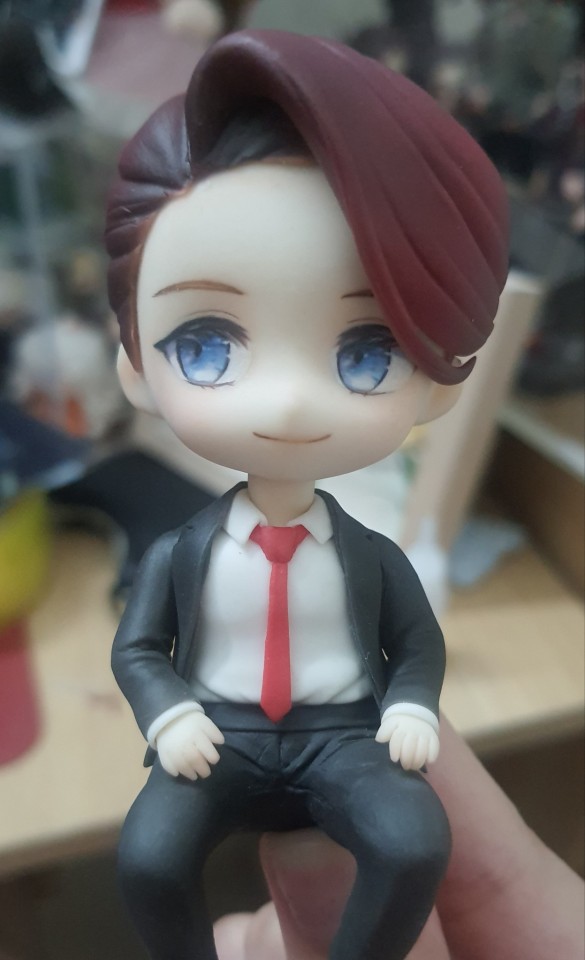

Bonus agent burnwood and miss 47, and also my nails I guess
Tiny posable dolls

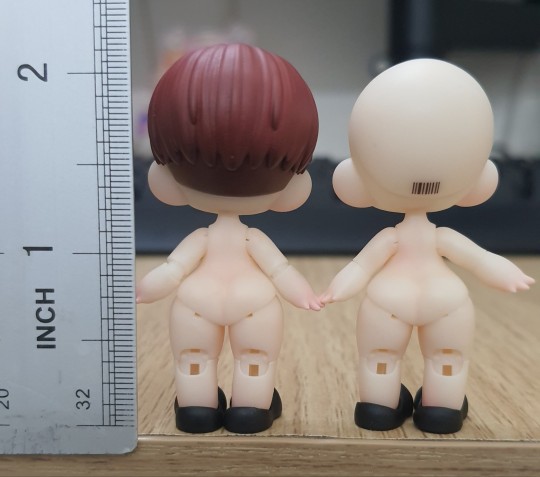

Once again, my drawing was used as a reference. These cost so much for such a tiny size that I would probably never do it again lmao ($150!!!!!!)
I do have nendoroid dolls in mind for the future though, but they will require more time since I have to source many parts like faceplates, hair sculpts, outfits, shoes ect
Despite the insane price, these are indeed very cute, and I'm glad my design was just slapped onto their faces, they look like my drawings have come to life and that's super cool
Last but not least,
Papercut drawing based on @/inuitaiyo's fanart:



+ desk setup, I finally found clothes for the plushies
I saw SUN's fanart years ago and it's been lingering in my mind ever since, so when I found an artist that can do papercut drawings, my mind immediately went to that artwork. It's my favorite 47 diana fanart, it's so subtle and amazing, and SUN's gorgeous style was the cherry on top. I'm glad that the artist I worked with managed to capture what I love about the original artwork
I had total control over the entire process of this comm, so I added a neat little detail: If you look under Diana's hair, you can kinda see her eyes looking down at 47's lips ehehehe. I made sure that was gonna happen no matter what lol. I'm so happy it worked so well
That's all for now. Next time should hopefully be me finally getting custom fourana nendoroid dolls + a 1/6 scale mendoza diana doll. We'll see, money is a limited resource after all
One more link to SUN's art to end this because I think it deserves so much more love
102 notes
·
View notes
Note
Apart from the old trial-and-error method, are there resources that you would recommend for the aspiring megadungeon architect?
Either tools for the mapmaking or books/articles for guidance on the matter.
I talked a little bit about resources on the subject here, and I still feel like there's not a great single resource on how to build a megadungeon that I would recommend. There definitely are some good articles, though.
I'd say the most essential in my view, and one you're likely aware of, is Jacquaysing the Dungeon. This is a great reference on building non-linear dungeons that are interesting to navigate, which adds so much to a megadungeon. The Alexandrian's other stuff on dungeons are also worth reading for the most part. For example, his series on Re-Running the Megadungeon is a solid demonstration of megadungeon practice for new or unpersuaded GMs.
Most of the great articles I've read on dungeon design are from OSR blogs. Some of those have been lost, since so much of that was on Google+, and in general I'm reticent to link to OSR blogs because of the issues in that space. But I'll link a couple that I really like that serve as a good starting point, and its pretty easy to sort of navigate the web of blogs from there.
One I quite like is the dungeon checklist from goblin punch. At a glance I think it feels a little basic, but whenever I go back to it I find something I've missed in my current dungeon and that sparks my creativity for another round. Another is this article from false machine, which I find extremely evocative and great at getting me to think about the dungeon as a real, tactile place. Neither of these is essential, but I just think they're neat, and a good place to start wandering the webs of OSR blogs and seeing what speaks to you for anyone new to that space.
For mapmaking tools, I personally just use GNU IMP and some of Dyson Logos' photoshop brushes because I ain't got time for all that hashing. But I remain a big advocate of doing mashups of other maps, using geomorphs, or random generators if you don't want to sit there and tediously map stuff out personally.
Sorry, this ask took me forever to get to, and aside from personal reasons, the other reason it took so long is that the answer is kind of just "no, I don't know of many good megadungeon resources." I think part of why I've been so motivated to write on the subject in the past is that I think so much of the existing advice is vague, scattered, or kind of just sucks and misses the point. And I'm sure there's a lot of good stuff I just haven't found. But nearly all the good stuff is for making good dungeons, and then the megadungeon advice is "do that but bigger" which I think is actually bad advice. Like it's bad advice in the same way that you can't just extend techniques on how to run an engaging battle into techniques on how to run an engaging war.
So, consider this an open call for anyone in the comments or reblogs to link any megadungeon resources they think are useful. Hopefully other people have more than I do.
38 notes
·
View notes
Text
What to ask for at a barber's shop, a butch guide
As promised, here's the ultimate butch guide to what to ask to your barber when asking for a specific haircut! A few premises: I'm not a barber, this means that everything you'll find in this post is purely based on my personal experience. If you're a barber and you see I explained something wrong, please correct me! I'll update the post asap. Furthermore, I won't cover up haircuts for black folks, because I'm not an expert on that topic, however I would love to link external and trustable resources on that so If any of you has them let me know and I'll add them! My intent is helping as many butches and studs as possible (: Second thing is that this post is more about short and really short haircuts, I won't talk about wolfcuts, middle part, mullets, however if you want I can make a post about them if requested! I think this is all I had to say, so let's start!
When visiting a barber, it’s important to know how to articulate what you want to ensure you leave with the perfect haircut. Understanding the difference between taper and fade, as well as the most common hairstyles that pair with them, can help you communicate effectively with your barber. Here’s what you need to know:
Understanding the Basics: Taper vs. Fade
Taper and fade haircuts are versatile and can be paired with various hairstyles, depending on the desired look. The terms "fade" and "taper" are often used interchangeably, but they refer to different haircut techniques:
Taper:
Subtle Transition: A taper gradually reduces the length of hair from the top down to the sides and back, but the change is subtle. When talking about "tapers," it's important to know that they can vary in style depending on how subtle or pronounced the transition is, where it begins, and how it complements the overall hairstyle.
Low Taper: The low taper starts lower on the head, around the ears or just above them, and gradually shortens down to the neckline. It offers a gentle, natural transition that’s less noticeable than other tapers
Mid Taper: A mid taper falls between the low and high taper, starting around the middle of the head. It offers a balance between subtlety and definition.
High Taper: The high taper begins much higher up on the head, typically around the temples. The hair shortens more quickly as it moves downward.
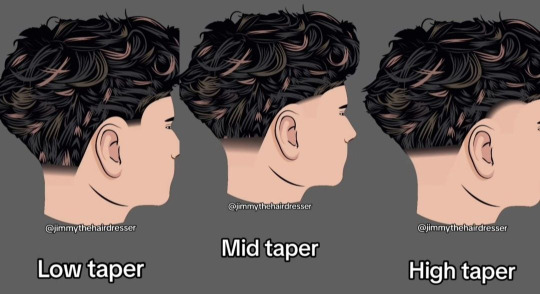
Tapers, source: Jimmythehairdresser on Tiktok
Fade:
Bold Contrast: A fade, on the other hand, involves a more noticeable transition where the hair gradually becomes shorter as you move down the head, often going down to the skin. As for the Taper, the fade starts at varying levels as well (low, mid, or high) depending on your preference.
Low Fade: The fade starts low on the head, just above the ears and around the nape of the neck.
Mid Fade: The mid fade starts slightly higher than the low fade, around the temple level.
High Fade: The fade begins high on the head, around the temples or forehead.
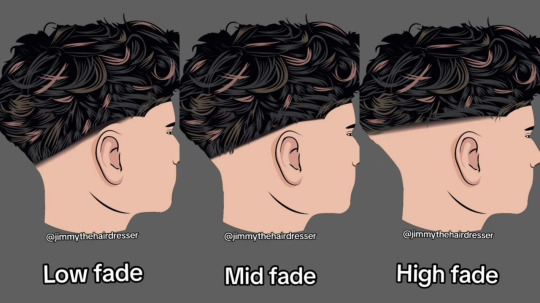
Fades, source: jimmythehairdresser on Tiktok
Bonus Fades:
Burst Fade: The burst fade creates a circular fade around the ear, leaving the hair longer at the nape. It resembles a "burst" around the ear, with the fade extending outwards.
Drop Fade: The drop fade follows the natural curvature of the head, "dropping" behind the ears towards the nape of the neck. It creates a more rounded silhouette compared to the straight line of a traditional fade.
The main difference between a fade and a taper is that the taper requires less maintenance. In order to keep the fade clean and neat you must go to the baber shop every two or three weeks.
Common Hairstyles to Pair with Tapers and Fades:
Once you’ve decided between a taper or a fade, the next step is choosing a style for the top. Here are some popular options:
French Crop: is a classic and timeless men's hairstyle characterized by short hair on the sides and back, with slightly longer hair on top that is usually styled forward. The defining feature of a French crop is its fringe (bangs), which is cut straight across the forehead or slightly textured, giving it a clean look.
Edgar: the most defining characteristic of the Edgar cut is its blunt, straight-across fringe (bangs). The fringe is cut very short and is typically styled straight down across the forehead. The sides and back are usually kept very short, often with a high fade or a sharp taper that contrasts significantly with the longer hair on top.
Textured Fringe: is a type of hairstyle where the bangs (fringe) are cut and styled to have a messy, layered, or choppy appearance, rather than lying flat or being uniformly cut. This style adds depth and movement to the hair. Sometimes is also referred as "fluffy" fringe on Tiktok.
Faux Mohawk: is a modern and versatile hairstyle that mimics the look of a traditional mohawk but is less extreme. Instead of shaving the sides completely as with a classic mohawk, the sides of the hair are kept shorter but not shaved, and the hair on top is styled to create the appearance of a mohawk.
Side Part: is a classic and timeless masculine's hairstyle that features a distinct parting on one side of the head, based on personal preferences or the natural hair grow pattern. The side part can be combined with different types of fades or taper with longer hair on top.
Slick Back: The defining feature of the slick back is that the hair is combed straight back from the forehead towards the back of the head. The goal is to create a smooth, uniform flow of hair. To achieve the slicked-back look, styling products like pomade, gel, or wax are typically used. The sides can be kept short with a fade or taper, creating a contrast with the longer hair on top.
Fringe Down: A fringe down hairstyle refers to a look where the bangs, or fringe, are styled to fall naturally down onto the forehead, rather than being swept to the side or styled upwards. The fringe can be cut in various lengths, from just grazing the eyebrows to longer, covering the forehead. The fringe down look can be combined with various fades, tapers or even longer sides, depending on the overall desired style.
Two Blocks: The two-block haircut is a hairstyle known for its distinct structure, featuring two contrasting sections of hair: a longer top section and significantly shorter sides and back. The style is versatile, easy to maintain, and can be adapted to suit various hair types and face shapes.
Styling:
When it comes to hairstyling, there are several key products that are commonly used to achieve different looks and hold styles in place. Each product has its own unique properties, making it suitable for specific hair types and desired outcomes. Here’s a breakdown of the most common styling products:
Pomade: Designed for more combed looks, such as side parts. It will give your hair a varied degree of shine and hold depending on the strength of pomade used. Pomade should be applied before you start styling your hair. It helps to shape and define the hair, making it easier to achieve your desired look by using a comb.
Wax: Hair wax is one of the most versatile hair styling products. Basically there are two types of hair wax, water based ones and oil based. It can give you a matte or high shine finish, depending on that.
Clay: Compared to Wax, Clay is usually dryer and a bit more stiff compared to a regular hair wax and that is what gives the product its hold and matte finish. For people with thinner hair a hair clay can be an option for some more volume when you apply it in damp hair before blow-drying.
Gel: Hair gel is somewhat similar to water based pomades. Both are relatively wet products, but hair gel is slightly wetter. The downside is that it is not very versatile. Furthermore, cheap hair gels are pretty chemically and they can leave white flakes in your hair when the product dries and you touch it too much.
Styling Powder: is a product you apply directly at your roots and then you piece it into your hair. This kind of product is great when you like to get some more volume in your hair and make it appear thicker and fuller. You hair will get more body, especially when you add it to your roots directly. Compared to other styling products, you need to apply them on already dry hair.
Sea Salt Spry: Sea salt spray mimics the effect of ocean water on hair, adding texture and volume for a beachy, tousled look. It’s ideal for creating casual, undone styles with a matte finish. It’s particularly popular for enhancing natural waves and curls.
Some final small tips:
When talking to a barber, clear communication is key to getting the hairstyle you want. Here are some final practical tips to help ensure you and your barber are on the same page:
Show a Picture: If you have a specific look in mind, showing a picture can be incredibly helpful, even better if it's a 360 video.
Ask for Advice: Your barber is an expert, so if you’re unsure, ask for their recommendations based on your hair type and face shape.
Mention Your Styling Routine: Let your barber know how much time you spend on your hair daily and what products you use. This helps in choosing a cut that fits your styling routine and maintenance preferences. Furthermore, if you have a specific lifestyle (e.g., active, formal work environment), let your barber know. This information helps them recommend a style that fits your day-to-day life.
Ask About Maintenance: Inquire about how often you should get the haircut maintained and any specific care instructions. This ensures you know how to keep your style looking its best.
Provide Feedback: If you notice something you don’t like during the haircut, give feedback politely and promptly. It’s easier for the barber to make changes if they’re aware of your concerns early on.
This is it, hope it can be helpful for some of you guys!
#butch lesbian#butch dyke#lesbian#lesbian haircuts#haircut#butch body#butch appreciation#butch positivity#dyke pride#dyke posting#dyke#masc lesbian#butch#masc#butch hair#butch haircut#dyke positivity#butch fashion#lgbtq positivity#lgbtq fashion#queer#queer hairstyle#lgbtq#transmasc#dykeposting#butchposting#teuta's guides
101 notes
·
View notes
Note
Oh hey, your art owns majorly, and I covet your skills muchly. I wanted to ask, how do you go about drawing portraits from imagination? Do you have any tips or resources you could recommend? Regardless if you respond or not, hope you keep drawing forever.
Thanks so much!
I guess I approach drawing people roughly the same way that I draw anything else: Absorb as much knowledge as possible, by whatever means possible, and experiment a lot.
I don't have any specific resources to recommend, but there are lots of good ones out there and they're all good for different things. "Anatomy for artists" resources are a great reference for the general forms, medical resources can explain the fine details, and studying other artists that you like can teach you a lot about interpretation and stylization (although be wary of learning detailed anatomy based on other artwork because nobody is perfect and you may not even be able to easily tell what they might have exaggerated on purpose). Even if you have a simplified style where you don't usually draw the subtle little details, any insight is valuable. The more anatomy you know, the more options you have to work with.
That said, nothing beats studying from life. And while you absolutely should draw live subjects when possible, it's good to remember that you don't need to be holding a pencil to absorb information. I think I just pay more attention to other people's faces than the average person whenever I'm looking at or talking to someone. Try to figure out what makes someone look distinctive, or attractive, or intimidating. How accurately do you think you can guess their age, or heritage? Based on which features? Is there any feature they possess that's different from anything you've drawn before?
Whenever you think you've learned something new, experiment with that knowledge! To me it feels like a waste of time to draw the same picture twice, so I'm constantly trying to come up with combinations of features, angles, styles, shapes and colours that I haven't used before. I think that artists who are less confident at drawing people tend more toward stereotypes (giving a 'manly' character all of the 'manliest' features, for example) and that can sort of work for some cartoonier styles, but I prefer a more realistic messiness. Real people don't fit into neat boxes and have all kinds of fun combinations of features. Sometimes I'll just start sketching a face without a plan in mind and won't really be able to tell the character's gender or race until I'm almost done. Other times I'll foresee it going in one direction and try to turn it around before the end.
If you always try to do something different then I think you eventually run out of boring choices and become forced to make more interesting ones, or at least choices which are new to you, which can in turn help you to develop new ways of thinking about a subject. And I do a lot of sketches, so I burn through a lot of ideas. Plenty of them are pretty mediocre and that's okay. 'Bad' art is just a byproduct of making 'good' art. If a picture turns out poorly then I just try to figure out what went wrong, save it anyway, file it away where nobody else will ever see it, and start a new one. The hundreds of drawings that I've uploaded to the internet are nothing compared to the mountain of stuff that I don't bother sharing.
Hopefully that helps a little bit!
#It's a complicated subject but I think I'll leave it there for now#shoutouts and apologies to the other person who sent me a similar ask last year#I tried to reply to that one but a Tumblr glitch ate it#tinydanceman#asks#not art#art tips#advice for artists#artists on tumblr
25 notes
·
View notes
Note
may a poor little wee boy ask how your colors / anatomy became so good? what are the practices? i might die of the plague soon so your secret will be safe with me
well the obvious answer is lots and lots of practice, but i'll do my best to give more specifics
alright so for anatomy:
it's pretty straightforward: i look at naked people( a lot of naked people)(including myself) and draw them. It helps a lot to make it more interesting by adding gore and/or being horny about what i'm drawing
It doesn't have to be neat or good it's just to get familiar with the shapes
Looking at how other people draw anatomy helps too. Medical anatomical illustrations are a great resource & i have a big skeleton poster right above my desk where i draw
for colours:
uhhhhhhhh man. uh.idk. i look at other people's art (including photography,film, anything visual) and if i find something i like a lot, look at how the colours are used. maybe make a palette from that and make art using it
a basic understanding of colour theory , especially types of contrasts is also very useful
to figure out a piece's colour palette i use photo references:

and i make my palette by colour picking from the images (and then messing with the colour balance and adding a colour blending mode layer if i think it's not coherent enough
it's a bit less straightforward for traditional art but the same principles apply
ALSO!! thumbnailing!!! especially if i'm indecisive or i have no idea where to start. I make multiple of them with diff colours and mess with them till one of them looks good
(keep in mind that i'm still learning myself and i don't have any formal art education so take all that with a grain of salt)
also here's a shmowder for your plague issue

#asks#i hope this makes sense#and is somewhat useful#i might add some stuff later if i realize i forgor something
89 notes
·
View notes
Text
Beyond the Bookshelves (3)
Pairing: Loki x Reader
Warnings: Obnoxious coworkers, what is the proper ettiquette when emailing princes, teasing Captain
Summary: You're a Resource Management Specialist at S.H.I.E.L.D. normally referred to as “The Librarian”. You've been assigned the nightmarish task of digitizing all the physical resources currently owned by the agency, with a few new computers and one extra helper.
A/N: Please comment/like/reblog. If you'd like to be tagged moving forward, please let me know!
The lovely banners used in this fic are from @cafekitsune.
If you’re new to the story, please check out the master post for the rest of the chapters.

The meeting was as boring as the fallen prince expected it to be, but he hardly showed his disdain for his time being wasted. Cabinet meetings and audiences with nobility and dignitaries were expected and mandatory for royals. In his opinion, a majority of them were hardly worth the time and could be easily sorted out with logic, but politics hardly worked that way. It was fickle, changing at the whim of whomever is more powerful. And though at times it was fun to see how the spoiled nobles would squabble over the most ridiculous things, the majority of it was always dull.
To think I once found such a thing mesmerizing as a young boy, wanting to follow my father everywhere and prove myself useful to him. A moment to shine, to step out of the immense shadow casted by my brother. The corners of his lips tugged downwards at the miasma of memories that began to stir. He knew the ledge was a precarious one and a single thought could have him plummeting to the depths and ensnare him.
“Do you have any questions?” The agent looked at the members of the group one by one, hesitating and nearly jumping over Loki to avoid eye contact.
“Agent Pruyn, was it?” He watched the man who was addressing them flinch at the call of his name. “Would it not be wiser for me to be the one who distracts them? I am able to change my image to look like anyone. I would merely need some footage of the person I am to imitate to better play the role. You will also be able to monitor my movements since I will be in the banquet hall as opposed to behind the scenes searching through the office.” Minimal footage of me in questionable places is best. Who knows what someone might do as an act of vengeance.
“No, this is the best plan of action. Hawkeye is better suited for that portion of the mission and needs support while Black Widow distracts the target.” Agent Pruyn cleared his throat. The lack of negative reaction from the others seemed to embolden him a little bit. “Also, are you implying that she can't handle it? Black Widow is the best undercover agent we have. She's successfully infiltrated hundreds of places while you've only failed at discretion.” He scoffed.
There it was. The bias and condescending tone, the twisting of his words, and the lack of support. Such insolence made his blood boil to the point of physically punishing the fool, but he kept his reactions in check with a blank expression. Silently, he changed the way they perceived him to look identical to the infamous fiery haired operative who was sitting with them. Everyone in the room stared at him in wide eyed shock, looking at him and her to see if there was a difference.
“Well isn't that a neat little trick.” Natasha was the first to break the silence. “Certainly beats needing to put on that holographic skin.” She leaned in closer, trying to find some flaw.
“Stare all you like, you won’t be able to tell the difference unless I let you.” He said in her voice.
“If he’s so good at keeping up an appearance, why not just swap them? Nat and I are equally able to get in and out without issues if there’s a good enough diversion.” Clint shrugged, though he was impressed at how perfectly Loki copied her.
“I don’t have an issue with that change, I’m the one who can break into the computer system they have. It’s better if I’m with Clint.” Natasha agreed, Loki shifting back to himself.
“So, we’re in agreement. I will be the one to keep the group busy and the both of you will gather the necessary information. As I stated, I’ll require footage and data on the individual I’ll be impersonating.” He turned his attention back to Agent Pruyn who seemed rather cross with the change to his plan but said nothing since the other two Avengers were agreeing with Loki.
“We’ll need to adjust the timeline of the operation then. Everything was set up for this plan, we’ll need to adjust and see if there’s another gathering we can infiltrate.”
“You say this person of interest has possible ties to this Hydra organization, correct? Why don’t we get ourselves invited to his home or wherever you think he is housing the necessary information? Why must we wait for some large gathering outside somewhere else?” Loki questioned.
“We can’t just waltz into his home unannounced.” Agent Pruyn scoffed. “Do you think he just calls people over for tea time? This isn’t one of your royal games, Loki.” The condescending tone was back once more with a sense of triumph. This was hardly enough to anger the prince, but he was not so lenient to let it slide for a second time.
“Who said anything about tea?” He looked at the agent with raised eyebrows. “I wasn’t aware you had the time for such frivolous plans. I must disappoint you, my plans do not allot time for such.” Agent Pruyn grit his teeth and glared at the insouciant attitude the Asgardian was speaking with to him. A few of the other members of the meeting snickered at the calm retort, looking away to avoid the ire of the presenter. “This target has questionable connections and has a proclivity to feign a charitable appearance through auctions. We need to approach him as someone equally shady who wishes to either wash their hands of some item or trade an item to someone else and obtain the money under the guise of donating to said charity. We simply need to choose someone from his connections or create someone completely new.”
“That,” Natasha was the first to speak, coincidentally cutting Pruyn off, “is an excellent idea. If we came as someone new, trying to make a name for themself, they’ll be more likely to accept us if we come with an item of great value. Loki can play the part of the client and I can easily play the part of his assistant as needed to keep up the facade. Once we’re invited in, I can get Clint inside and we can get the information we need while the auction is going on.”
“Until the auction takes place, we can build a relationship with him and others. We can record all the conversations and pick up on any codes they use to discuss the secret dealings!” A female agent chimed in soon after, realizing an extra benefit to this plan.
“This makes it a much longer plan than anticipated though, we’ll have to resubmit the plan to our lead agent and to Director Fury.” A male agent pointed out.
“Sounds like it’s a necessary delay if it’s going to be more fruitful than the original operation. I guess Thor wasn’t exaggerating when he boasted about how strategic you are.” Clint slightly nodded his head in approval. “Redraft the plan and submit it, we’ll see what Fury says before moving forward.”
“We’ll schedule our next meeting after that.” Natasha nodded, standing from her seat. The others followed her actions and the meeting came to an end with a very irate Pruyn glaring at the back of Loki’s head. A small smirk of satisfaction tugged at the Asgardians lips as he walked down the halls, feeling lighter at proving himself as worthy to be on the team.

Y/N stared at the screen of her computer, willing it to fill the empty body of the email that was addressed to the two Avengers she was allowed to work with. Glancing at the time, she groaned audibly and turned her chair around so her back was to the screen.
Three hours, I’ve been staring at this blasted computer screen for three hours! Why do I need to message them!? Wasn’t Agent Hill supposed to coordinate this? Why is everything suddenly dumped on me from start to finish? This is ridiculous! Next they’ll want me to manage their schedules and make sure they have time to complete their missions and assist in my never ending task! I am not some over glorified secretary, I am the head of the Resource Management department, the director of it! I attend all the ridiculous morning meetings, check-ins, and any other waste of time meeting that could have easily been an email instead while managing all centers that contain our resources, digital and physical! She pushed herself out of the chair and paced in the space she had behind the desk. “When am I supposed to even meet with them when both are due to be deployed this week!” She threw her hands in the air as she shouted into the empty office. Defeated, she slumped back into her seat and turned to face the computer once more.
She did not want to wait until their return, she needed it done now so that while they were gone she could have the computers and scanners set up and be ready to start as soon as they returned. Straightening up her posture, she pulled the keyboard forward and quickly began to type a brief email stating she was approached by Agent Hill and wanted to set up a short meeting in person to introduce herself and better understand how to properly utilize their assistance and time. She also added that the both of them are available tomorrow after lunch for a brief period of time. Rereading her email over and over again, she made sure there was no error before finally hitting the send. Now she had to wait for a response. Thankfully, the chime signaling the door opening was a great distraction, letting her escape the panic while waiting for a response.
“Good afternoon, how may I help you?” She happily greeted the person as she stepped out of her office. “Oh, Captain Rogers, how are you?”
“Good afternoon Y/N, I’m doing well. How are you doing?” He smiled, giving her a slight nod.
“Could do with less work, but that’s not going to change anytime soon.” She tiredly chuckled.
“I don’t know how you handle your work at all. I wouldn’t know the first thing to do with a fourth of what’s here. They’ve got the right gal for the job here.” He patted her on the back. “Which is an expertise I’ll be needing at the moment. I’ll be going out on a mission with Thor and Tony to a fairly remote area with indigenous people. Thor will be a great asset with his AllSpeak, but I’d like to get some insight on the culture.”
“Oh, so no “An American Girl” books this time around? Or the “Hardy Boys”?” She curled her lips inward to keep from laughing as she watched the famous Captain America clear his throat and turn away to hide the hints of a blush that were creeping up onto his cheeks.
“No, not this time. But maybe when I come back you can suggest something for me to read?”
“I would love to, I’ll think up a small list and let you see which you’d like to start with. So, back to your mission, where are you going and do you know the group you’ll be interacting with?” She clapped and rubbed her hands together, eager to be of assistance. “Let’s head to the front desk while you tell me so I can pull up what we have for you.” Nodding his head, he delved into the details of the mission that were necessary, Y/N never asking for more information than necessary as she pulled up anything relevant and jotted it down on a sheet of paper. “Ok, follow me!” She walked back around just as the chime signaled someone else coming in. “Good afternoon, if you need my assistance I will be with you shortly. Please wait at the desk.” She turned to smile at the newcomer only to see the raven haired prince. Oh, good thing I put the book on the table already. “Follow me, Captain Rogers.”
“Y/N, you can just call me Steve. I think we’ve known each other long enough to drop formalities.”
“Captain Rogers, so bold and scandalous!” She gasped. “What would your fangirls think?!”
“Please don’t remind me of those.” He sighed heavily and gave her a stern look. “And I insist you call me Steve, we’re friends.” He flashed her that famous hero smile.
“Alright, alright, Steve it is.” She turned into an aisle and began to skim the codes, pulling out books which were taken from her by the gentleman super soldier beside her. Once everything was pulled, the two went to the nearest table.
“This is great, thank you, Y/N.”
“Anytime Capt-,” she stopped at the pointed look he gave her. “Steve. If you need anything, just give a holler. I’ll come help you.”
“We’re in the library, I don’t think hollering is a good idea.” He chuckled.
“Who’s going to stop us, the librarian? Oh wait, that’s me!” She grinned, earning an eye roll from him before he turned his attention to the books he had as she made her way back to the front desk.

Tags: @vbecker10 @huntress-artemiss@softestqueeen @thegodofnotknowing @princess-ofthe-pages @firedrakegirl@rcailleachcola @cabingrlandrandomcrap @lotrefcp @lwtannie @kats72 @jainaeatsstars @mssjsg7 @tom-hlover @kneelingformyloki
#loki marvel#loki god of mischief#loki odinson#loki#loki laufeyson#loki mcu#mcu loki#loki friggason#loki x you#loki x reader#loki x y/n#loki avengers#the avengers#avengers fanfiction#avengers fanfic#loki fanfiction#loki fanfic#tom hiddleston#reader insert#y/n#your name#agents of shield#shield agent reader#s.h.i.e.l.d.#agents of s.h.i.e.l.d.#black widow#natasha romanoff#hawkeye#clint barton#captain america
100 notes
·
View notes
Note
Hello!! Years ago you recommended an anatomy book you carried with you all the time and it really helped you... Can you please tell about this book again? Your art always inspired me <3 have a great day!!!
Of course! Since then I've actually picked up a few more books that are great for anatomy:
Classic Human Anatomy by Valerie L. Winslow This is probably the book I recommended years ago and it's excellent. It goes in depth into anatomical breakdown and how motor functions affect how the body looks visually with plenty of drawn visual references.
Anatomy for the Artist by Sarah Simblet This one includes both drawn and photographs of live models to visually explain anatomy. It even has a neat feature in each section where a translucent page with a drawing of the skeleton overlays the next page of a photograph of a real body. It really helps you visualize and understand how the different structures of the body line up and affect each other!
Morpho: Fat and Skin Folds by Michel Lauricella This book is essential. It does a phenomenal job of explaining how weight, fat, and age affect anatomy and express the variation of the human form. It's abundant in visuals and I highly recommend it!
The Body: Photographs of the Human Form by William A. Ewing I actually picked this book up from my artsy grandmother's collection haha. It isn't really an anatomy book per se, it's actually more focused on the art of photography but some of the poses included are very gestural and would be great to use as reference. Fair warning: some photos included in the book are disturbing! The "Estrangement" chapter specifically includes depictions of death, disease, and genetic deformities.
line-of-action.com I know this isn't a book at all but it's a wonderful resource that allows you practice some life/figure drawing! It even includes a setting that simulates the timing they use in an actual class setting. I highly recommend doing a session with friends! My friend and I do a call in discord and I share my screen of the website while we both draw off it. We even compare and critique each other's drawings after. It's a great way to learn and a lot of fun!
Hope these resources can help! Have a great day :)
86 notes
·
View notes
Text
all my mandarin dictionaries (and dictionary-adjacent books)
Through chatting with @don-dake and @cherrymintvampyyri, I've come to realize that I might own a less than normal number of Mandarin dictionaries. So, here's a post about all of them.
I do have two basic bilingual dictionaries (Mandarin/English): the Langenscheidt pocket dictionary and the DK visual dictionary. These are quite easy to buy and not that interesting imo, so I'm not gonna talk further about them.
I'm also going to include a couple books that aren't technically dictionaries, but are rather about etymology of characters, and that's close enough to count for me.
Okay, let's get on to the interesting stuff!
1. What Character is That? An Easy-Access Dictionary of 5,000 Chinese Characters by Ping-gam Go (second edition, 1995)
bilingual
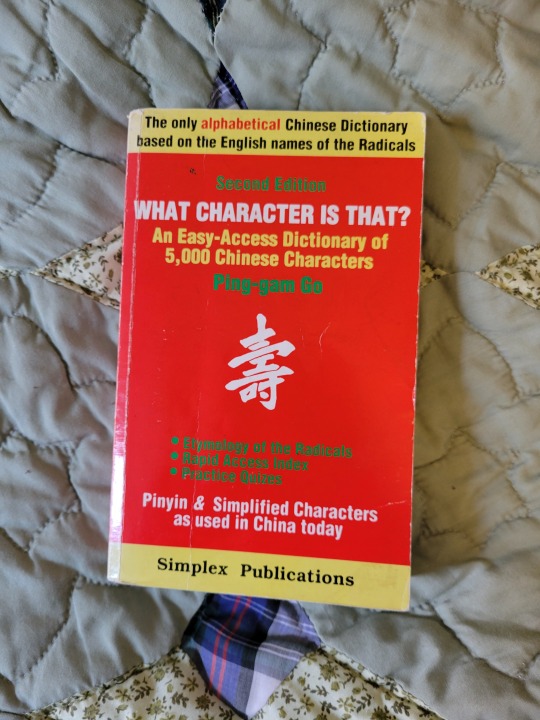
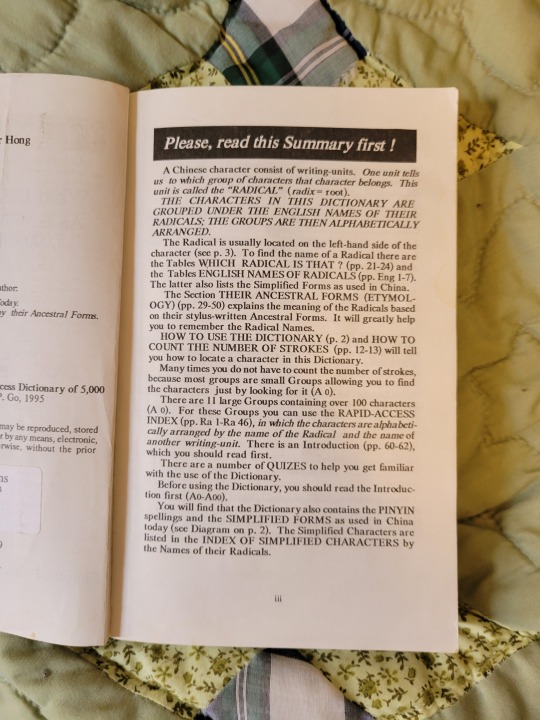

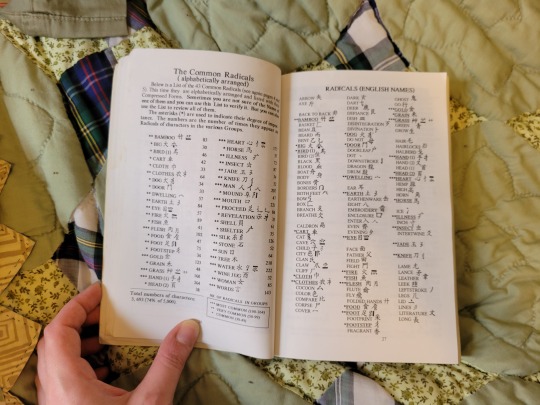

This strange little dictionary was gifted to me by a nun who went to high school with my grandma and later lived in China as a missionary. It's organized alphabetically based on the English translation of each radical?
I have not used this dictionary for actual reference ever, because I flipped through it once and realized that it was absolutely whack. But it's cool to have I guess.
2. 新华字典 第11版
monolingual
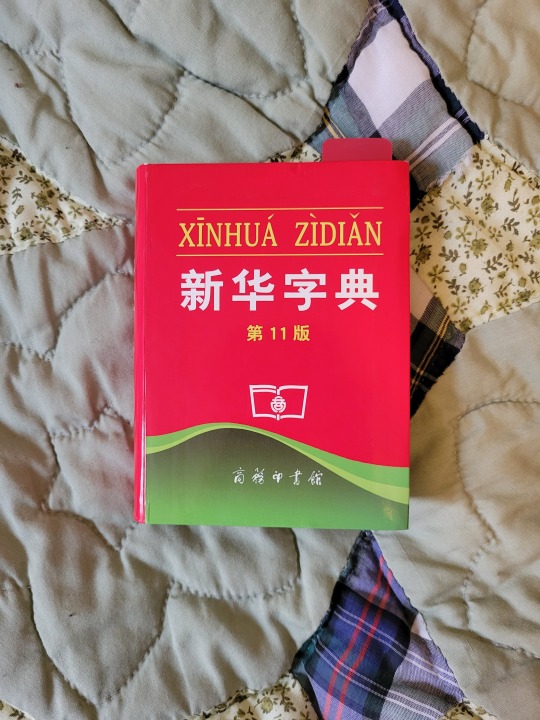
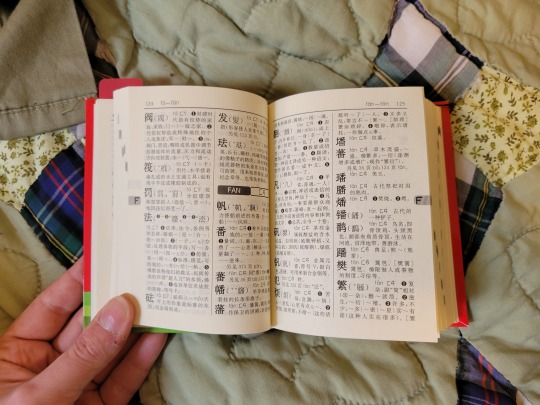
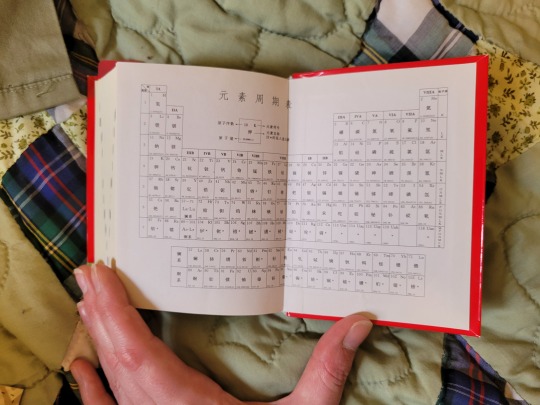
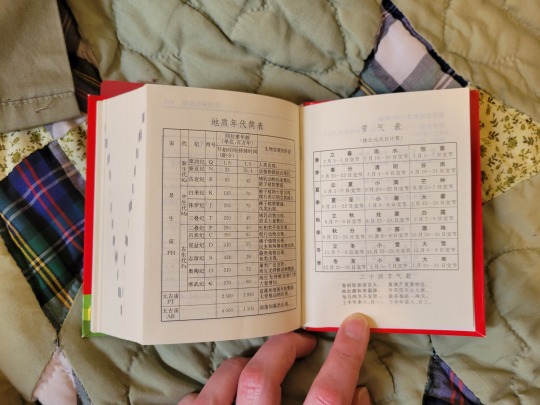
This little guy was gifted to me by a Chinese classmate back when I was in college. It's a 字典, so it's just focused on defining individual characters and providing some words featuring that character. Despite being a mainland dictionary, it also has 注音 next to each character for some reason.
It's got some neat stuff towards the back, like the periodic table and a chart of all the 節氣 solar terms.
3. 小学生全笔顺 同义词 近义词 反义词 组词 造句 成语 多音多义字 词典
monolingual
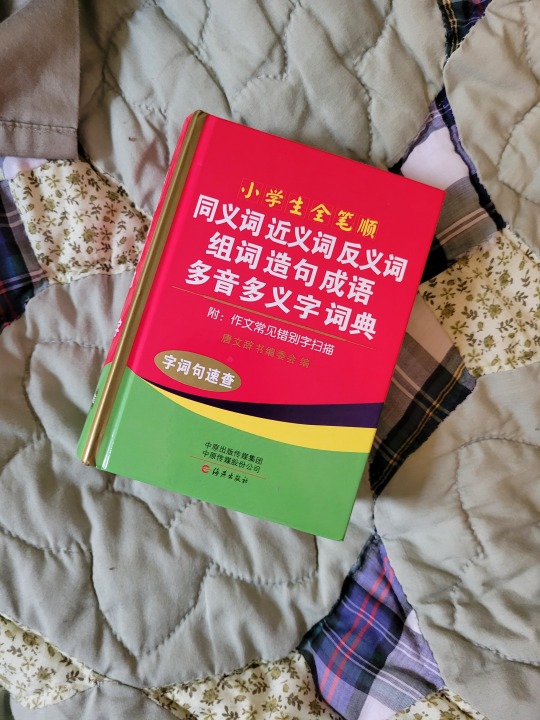
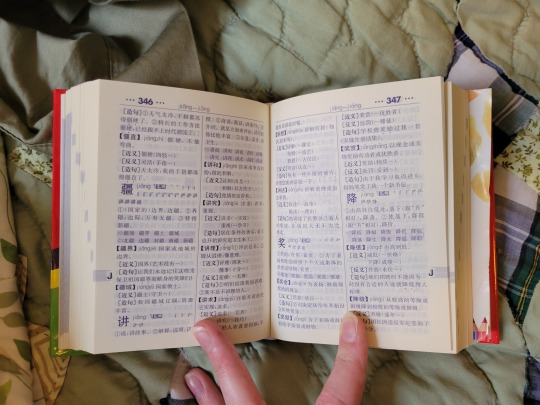
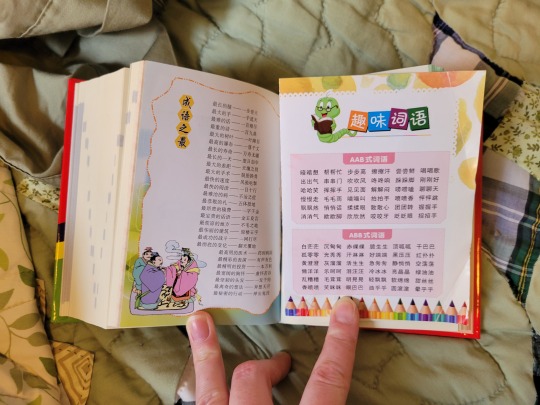


Whew, that's a mouthful. This is an actual 词典, so it defines full words. It also provides example sentences, synonyms, antonyms, and close equivalents. Then there's a section for idioms, and another section for 多音多义字.
There's also this nifty little insert with examples of words/phrases that follow common patterns of repetition.
4. 新现代汉语词典
monolingual

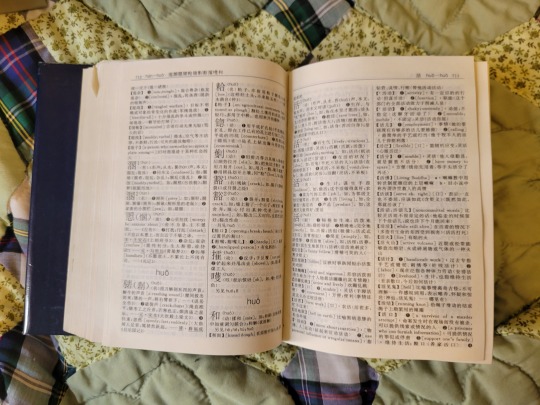
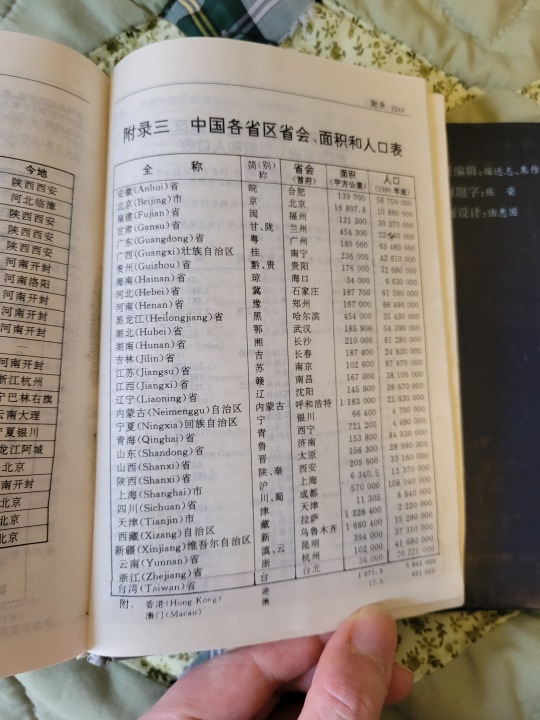
I picked up this chunky guy from a used bookstore down the street from me (the owner of the store passed last year, and the store is no longer there unfortunately). This is a fairly normal dictionary, it's just bigger than my others and has more words listed in it.
One thing I also noticed is that this chart towards the end of the dictionary apparently had a strip of paper pasted on the bottom. It doesn't seem like something I can peel up without damaging the paper under it, and when I shine a flashlight through the page I can't make out any major differences between what's on the sticker and what might be on the page under it. So my best guess is there might have been some damage to the text on the page?
5. 商务馆学汉语近义词词典 The Commercial Press Guide to Chinese Synonyms
monolingual
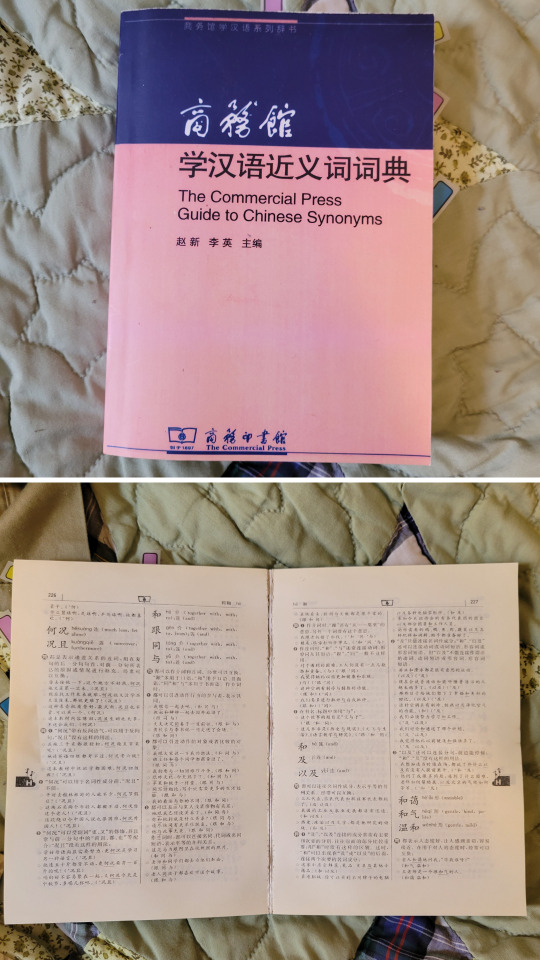
This book is easily the one I reference the most. As the name suggests, the book is all about synonyms. It takes sets of 2+ similar words and thoroughly explains the similarities and differences between them all. There's plenty example sentences, with notes about whether the synonyms can be used interchangeably in certain contexts.
It's a great resource, but I had a bit of trouble getting my hands on a copy. It's possible that in the years since I bought it there have been more copies made available for sale though.
these next two are books I haven't explored too much since they are old and the binding is incredibly fragile and starting to fall apart. just opening them is stressful.
6. 漢字分解 Chinese Characters Explained by F.X. Keelan (aka 康愛玲修女) (1967?)
bilingual
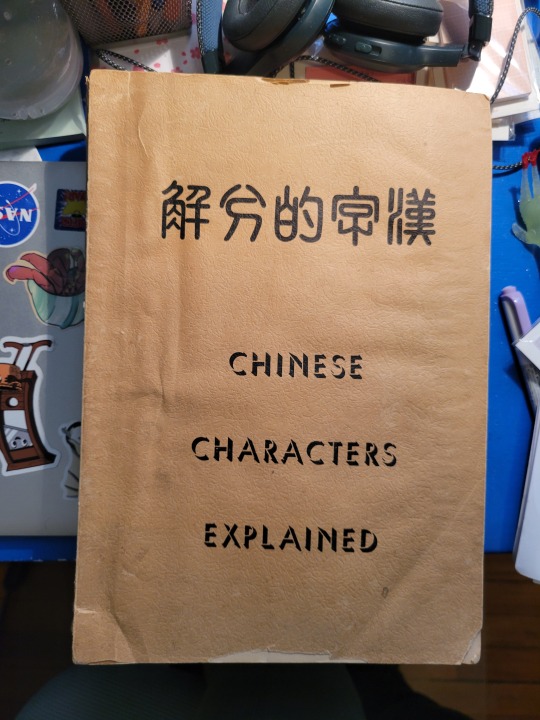
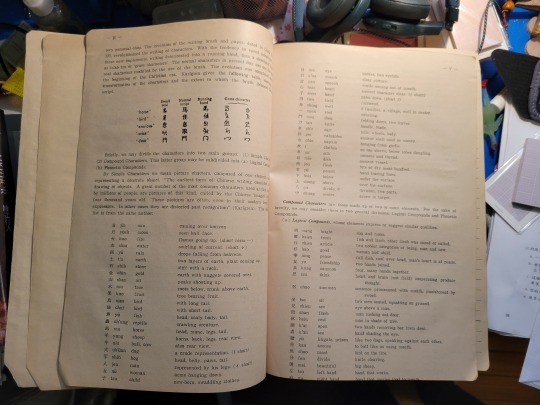
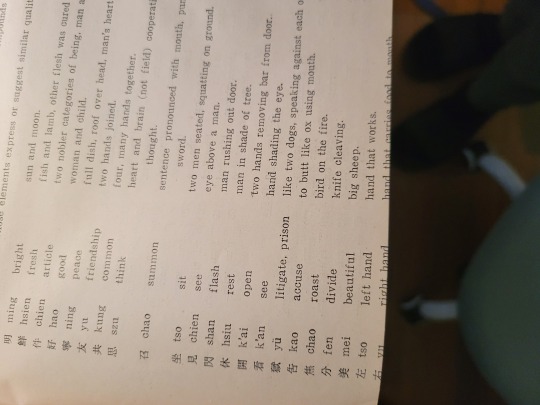
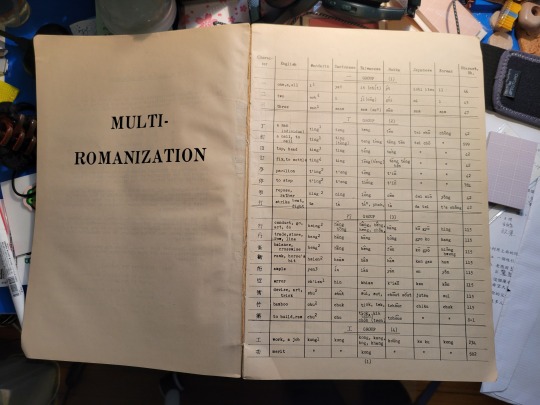
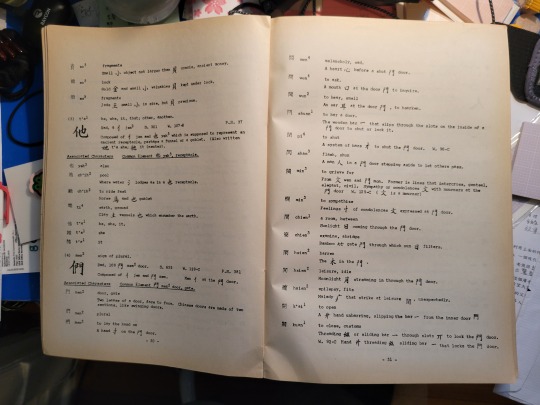
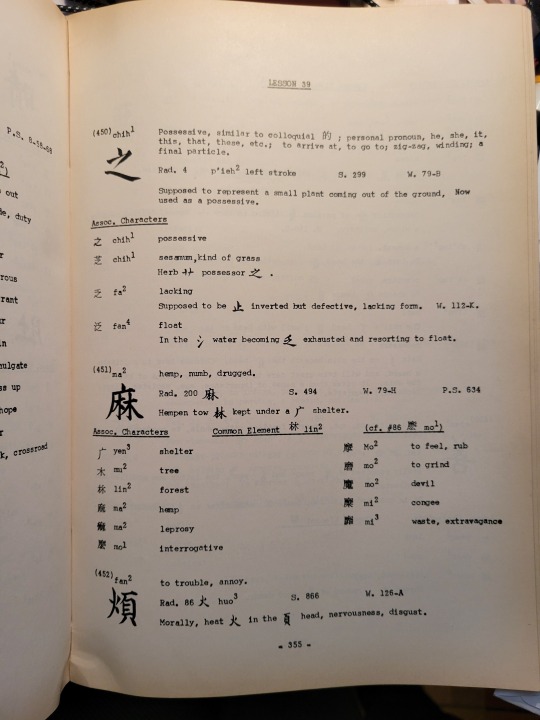
This book was also gifted to me by the nun who went to school with my grandma, and appears to also have been written by a nun! Based on what I've found from Google, this book was published in 1967.
Rather than a dictionary, this book is "a compilation intended as an aid in grouping and remembering [Chinese characters] with a view in acquiring a reading knowledge of Chinese"(p. iii). It aims to break down characters into radicals and giving similar/related characters. It's apparently the final installment in a 4 part Mandarin Course.
This book uses traditional characters. According to Google Books, the publisher is 光啓出版社, which is a Taiwanese organization. The book includes a very long table that has Mandarin, Cantonese, Taiwanese, Hakka, Japanese, and Korean pronunciations for (what seems to be) every character mentioned in the book. The intro mentions that this is so the course is more "accessible" for speakers of other East Asian languages.
Also, look at that printing error in the third photo! The text got cut off at the bottom of the page.
7. The Structure of Chinese Characters by John Chalmers (second edition, 1911)
bilingual
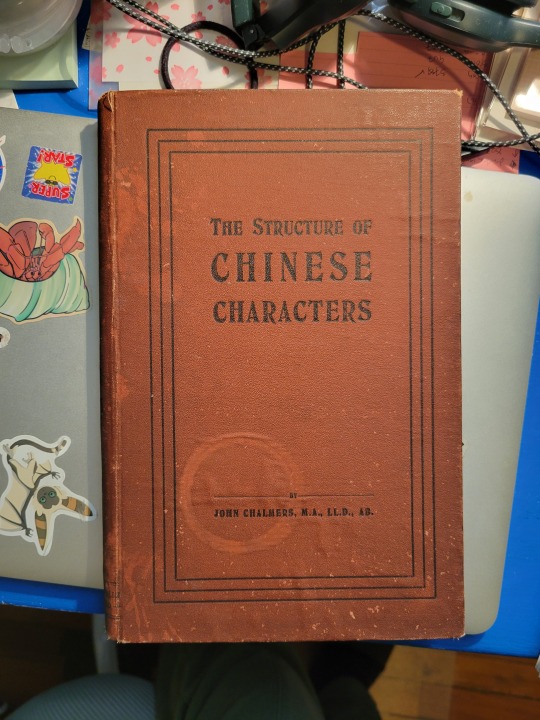
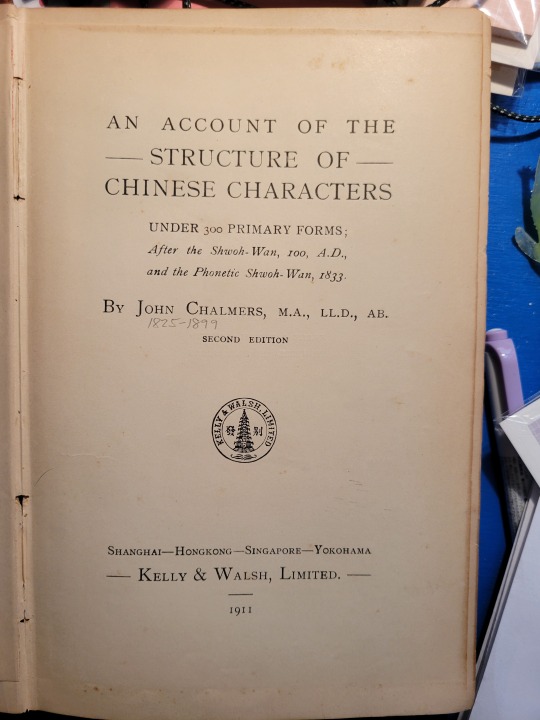
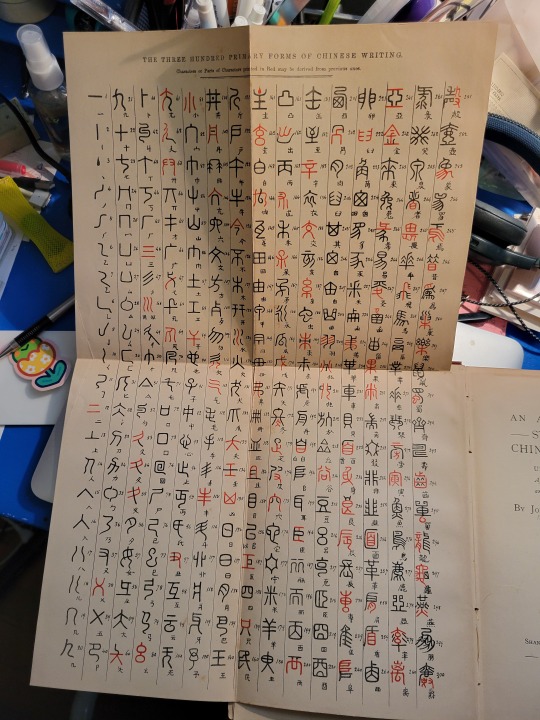
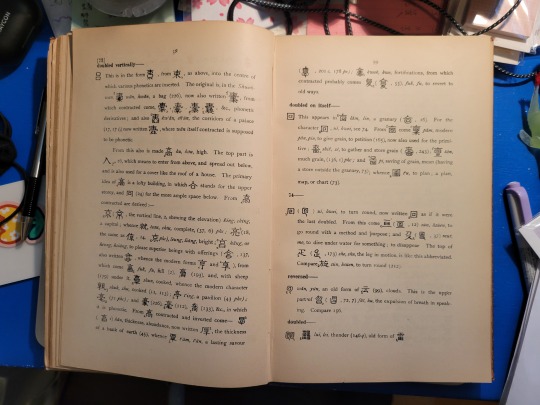
This final book is the oldest of the bunch, and was gifted to me by my boss's boss for some reason? She found it in a used bookstore apparently.
This book also uses traditional characters, because simplified characters just weren't a thing yet in 1911. This book is falling apart, and opening it stresses me out. It creaks whenever I open it.
Going by the title page, the full title of this book is An Account of the Structure of Chinese Characters Under 300 Primary Forms; After the Shwo-Wan, 100 A.D., and the Phonetic Shwoh-Wan, 1833. It was published by Kelly & Walsh, which was a Shanghai-based publisher.
Someone very kindly penciled in the years the author was alive: 1825-1899. John Chalmers was apparently a Scottish missionary (bc of course he was) who apparently popularized the term "Cantonese". This book that I own in particular was originally published in 1882.
It is, as the very long title suggests, an analysis and etymology of 300 common components
It also has a nifty fold-out of all 300 "primary forms" in seal script.
95 notes
·
View notes
Text
Who's Read What in Dracula? Masterpost
This is a little self-assigned project to try and keep track of who has read (as well as written) what documents, and, importantly, when they do so. Last year I spent some time thinking about this and it informed some of my thoughts about specific characters' perspectives and actions in interesting ways. So I thought it could be a neat resource to have for others!
I'm going to update this in time with the novel, so there won't be any spoilers. This post is going to be a master reference, with links to each individual character's posts. I originally wanted to do this as a series of graphs for each character, with color-coded bars for each document they've read, but I'm not savvy enough to figure out a non-confusing way to do so, especially given the number of different authors/documents. Instead, I'm going to have a separate post for each character, and just have the info in written form there. Here are the links to each of those, in order of introduction:
Jonathan Harker
Mina Murray
Lucy Westenra
Jack Seward
Quincey Morris
Arthur Holmwood
Abraham Van Helsing
Some housekeeping notes: Obviously, each character will have read their own writing. I'm not going to update day-by-day for any such things. Instead, I'll only update whenever they access new information by someone else, or begin what I'm counting as a new document.
Most of the time, we know for a fact when characters get access to a new document. However, there are a few exceptions. I have my theories, but I will mark them as speculative whenever that label applies.
I break up documents based on chunks of information and have assigned titles to them as such. The labels may change as time goes by as needed to avoid spoilers. I also try to add in dates, but for any longer accounts it will just be a range of dates rather than every entry.
Below the cut is a list of all the documents, in order of appearance, with dates. I'm using color-coding for all the main authors, which will match the colors used in individual character posts. This too will be updated over time, so no worries about spoilers here either. Unless, of course, you don't want to know if someone who has only written once before will go on to write often... in that case, don't look below.
Castle Dracula Diary (3 May-30 June) - Jonathan Harker
Invitation to Castle Dracula (3 May) - Count Dracula
Letter to Innkeeper (4 May) - Count Dracula *
Letter to Dracula (5 May) - Mr. Hawkins *
Letters to Lucy (9 May, 17 May?*) - Mina Murray
Letter to Mina (2/3 May?) - Jonathan Harker *
Letters to Mina (11 May?, 24 May) - Lucy Westenra
Dictated Letters Home (11 May, 18 May) - Jonathan Harker *
Letters to Various Solicitors (11 May) - Count Dracula *
Phonograph Diary (25 May-?) - Jack Seward
Letter to Art (25 May) - Quincey Morris
Telegram Reply to Quincey (26 May) - Arthur Holmwood
Intercepted Letters Home (28 May) - Jonathan Harker *
Renfield's Notebook (5 June?-?) - R. M. Renfield *
Log of the Demeter (18 July-4 August) - Captain of the Demeter
Whitby Journal (24 July-19 August) - Mina Murray
Message to Lucy (27 July) - Arthur Holmwood *
Demeter Articles (8-9 August) - Daily Graph Correspondent
Letter from Budapest (12 August) - Sister Agatha
Letter to Carter, Paterson, & Co. (17 August) - Billington & Son
Letter to Mina (17/18 August?) - Mr. Hawkins *
Letter to Billington & Son (21 August) - Carter, Patterson, & Co.
Post-Whitby Letter to Lucy (24 August) - Mina Murray
London Diary (24 August-17 September) - Lucy Westenra
Whitby Letter (30 August) - Lucy Westenra
Letter to Jack (31 August) - Arthur Holmwood
Telegram to Jack (1 September) - Arthur Holmwood
Letter to Van Helsing (1 September?) - Jack Seward *
Letters to Arthur (2, 3, 6, 15?* September) - Jack Seward
Letter to Dr. Seward (2 September) - Van Helsing
Telegrams to Van Helsing (4-8 September) - Jack Seward
Telegram to Arthur (8 September) - Jack Seward
Telegram to John (8 September) - Van Helsing *
Telegram(s?) to Vanderpool (10, 13? September) - Van Helsing *
Delayed Telegram to Seward (17 September) - Van Helsing
Lucy's Memorandum (17 September) - Lucy Westenra
Unread Letters to Lucy (17, 18 September) - Mina Murray
Escaped Wolf Article (18 September) - Pall Mall Gazette
Telegram to Quincey (18 September) - Arthur Holmwood
Mrs. Westenra's Death Certificate (18 September) - Jack Seward/Van Helsing *
Telegram to Arthur (18 September) - Quincey Morris *
Telegram to Summon Arthur (19 September) - Jack Seward *
Hennessey's Report (20 September) - Patrick Hennessey
Letter to Mrs. Westenra's Lawyer (21 September) - Jack Seward *
Post-Whitby Journal (22 September-?) - Mina Murray
Telegram to Mrs. Harker (22 September) - Van Helsing
Letters to Mrs. Harker (24-25 September) - Van Helsing
Bloofer Lady Articles (25 September) - Westminster Gazette
Telegrams to Van Helsing (25, 29 September) - Mina Murray
Telegram to Mina (25 September) - Jonathan Harker *
Letter to Van Helsing (25 September) - Mina Murray
Post-Castle Diary (26 September-?) - Jonathan Harker
Carfax Letters (pre-3 May?) - Jonathan Harker *
Letter from Ring (24/25 September?) - Arthur Holmwood *
Note to Jack (24/25 September?) - Quincey Morris *
Undelivered Note to John (26 September) - Van Helsing
Note to Arthur and Quincey (27 September) - Van Helsing *
Message to Billington & Sons (27/28 September) - Jonathan Harker *
Reply from Billington (27/28 September) - Mr. Billington *
Telegram to Jonathan (29 September) - Mina Murray *
Carter Paterson Documents - Carter, Paterson, & Co *
* We know these documents exist, but never get to read them (or in one case, only get a brief excerpt) as they aren't added to the record. Sometimes some of the main characters do get to read them, but not always.
Question marks after a date denote uncertainty, though they're all likely written within a few days of the tentative one listed. When after a dash (-?) they mark an as-yet incomplete document.
Some documents contain others within them. When this becomes relevant for characters reading them, I will list the main document read, then all others included in it with brackets, like this:
Main document [included document one, two]
#dracula daily#wrwd#wrwd masterpost#dracula meta#my meta#no one has ever asked for this. i just find it fun#both years so far i think 'probably not gonna be posting as much about dracula this time around' and then immediately start tracking stuff#or writing metas etc#also i'm doing this as we go so who knows if this format will work. hopefully so but if not i'll try to figure it out when it comes to that#dracula documents#can't believe i forgot that tag that's literally all this is
70 notes
·
View notes
Text
KNOCK KNOCK *kicks down your door* time to talk about Cloutchase Vol 5!
Be sure to check out the previous installments: [1][2][3][4]
Good evening Tumblr! It took two days to play through Volume 5 this time because my friends and I also read through Discord's Holiday Party and the bonus room. I'll make a separate post about the former soon, and I will link it here once it's done. BUT LETS LOOK AT THE MAIN GAME FIRST!
Here are your usual two screenshots for enticement:


Remember to play the game yourself before clicking the Read More!
I, of course, played this with my usual friend, who I will simply refer to as Ams. I play through all the routes with her and it's been a genuine delight. I was also joined by my other friend, who I will call Knight. I have posted about him in the Cloutchase tag before, as I have used two of his messages as meme material for both Ao3 and Wikipedia. Thus, he has voiced both of them in this week's playthrough hahah

I immediately noticed right off the bat that Ao3's books are stacked in the colors of the Homestuck troll blood colors. Rust, Bronze, Gold, Lime, Olive, Jade, Teal, Cerulean, Indigo, Purple, Violet, and Fuchsia. There's probably a Candy Red beneath his palms as well. I understood that reference. Anyway, I absolutely love his gimmick of having tropes follow him around, that feels like both a dream and a nightmare. We all love reading fic but we never wanna live it

I wanted to include this photo cause I just love the art. Angst angst angst angst angst! But also dang User got some sick canines wtf-

This line made me have to explain Troll Jegus to my non-homestuck friends, how freaking dare you. Ams got it faster than Knight though, he's very slow on the uptake-

I know I put this image in the post already but I just have to say, Ams and I saw this and were like "oh noooooooooooooooooooooo" and Knight was a clueless bystander who has never read fanfic in his life and sat there like "E for Everyone :3" the poor soul
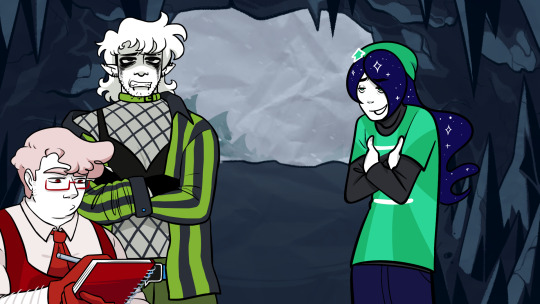
I absolutely love how eloquent Ao3 speaks and writes. I know not all fics are as fancy as this, but I greatly relate to writing with all my LA class lessons in mind. Also, I think this is Imgur's first actual sprite appearance, so that's neat! I could be wrong though, I don't remember if User has even properly met her before. Ao3's writing sprite is so cute btw
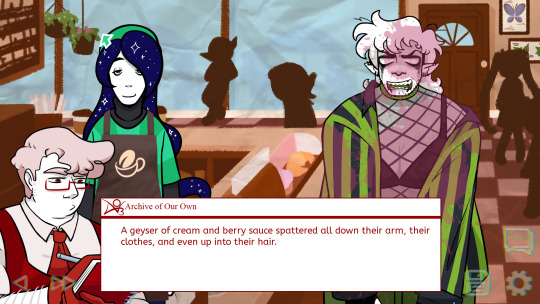
Love the new Kik characterization too. This may be fic, but I bet it's canon (delusional). WAIT IS THAT HATSUNE MIKU-
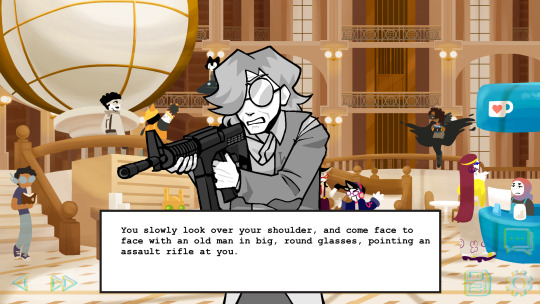
By far the best introduction of any character so far. If you've seen any of my posts with Knight in them, you know he was DELIGHTED to see this (his username on the Cloutchase Discord server is literally "Wikipedia Firearms Broker"). He did however complain that this gun does not have a scope, or something idr

Hahah uh how did he know the grid is my laptop wallpaper- (it's been my wallpaper for like two years now lol, or whenever this screenshot was made available to me)
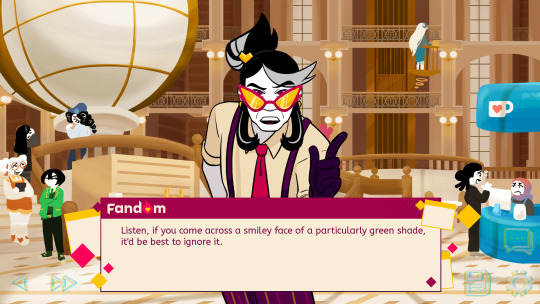
Very ominous Fandom, love to see it. I will admit, I used both Wiki and Fandom to find resources for my final essay this past semester. I just used them to find sources not as sources I promise- uh anyway this character design slaps and I love evil old women

When Knight read out Wiki's dialogue, he actually said the full name of the gun out loud instead of just "AR-15." I'd type it here but I don't remember it, I was not blessed with the firearm hyperfixation like he. Anyway when Quotev asked what our favorite emoticon was all of us said colon three. Quotev is amazing here btw, she was a highlight of the route for me

WAIT WAIT WAIT WAIT WAIT I'VE SEEN THIS BEFORE-

ON AJ'S BLOG!!!!!!!!!!!!!!!!
@applejuiceyjuice-art get clocked /j (lmk if u want me to remove the @)

AM I MS. BLOG RUNNER'S SECRET LOVE CHILD??????

Okay so after getting all of Wiki's endings I went back to see if the board changed AND IT DID and that was by far the FUNNIEST thing of the entire route. Makes me wonder if all the other route bad ends are also supposed to be here or not
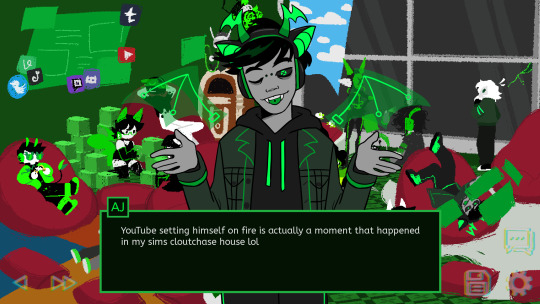
Last thing I wanna put here, AJ you gotta show me ur sims cloutchase house I would like to witness the chaos. Also, there's a lot more devs in the dev room! That's so nice to see, I'm glad ur team is growing!
Sorry that I haven't been very active in the community, college has been kicking my butt and all that, but you guys are genuinely doing a great job and I love playing this game with my friends! Heck, this game even saved my friend's life because she agreed to play Instagram's route with me the day she was considering ending herself, so thank you for that, too
I'm super interested in how the Admin lore is going to play out in future volumes, as well as being able to meet more sites! I'd say Wiki's was my favorite of this volume because of the ARG-type vibes (well, not really an ARG, more like conspiracy hunting iykwim), but I loved Ao3's fanfiction writing activity and read through all 8 stories with my friends together :3
Like I said at the top of the post, we also played Discord's holiday party, so I'll make a smaller post about that later. It'll be linked at the top when it's done, but if I remember I'll put it down here too
The bonus room heavily implied that 4Chan's route is being replaced with Pinterest, and I can only assume it's because of the recent website crash. I still hope to get a 4Chan route in the future, though, but that's all for now!
Thanks for reading, and I'll see you all in the next one!
#cloutchase#socialstuck cloutchase#socialstuck#homestuck#friendsim#visual novel#wikipedia cloutchase#cloutchase wikipedia#ao3 cloutchase#cloutchase ao3#cloutchase vol 5#cloutchase volume 5#wikipedia#ao3#archive of our own
11 notes
·
View notes